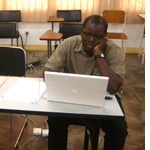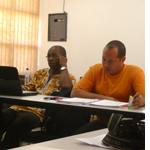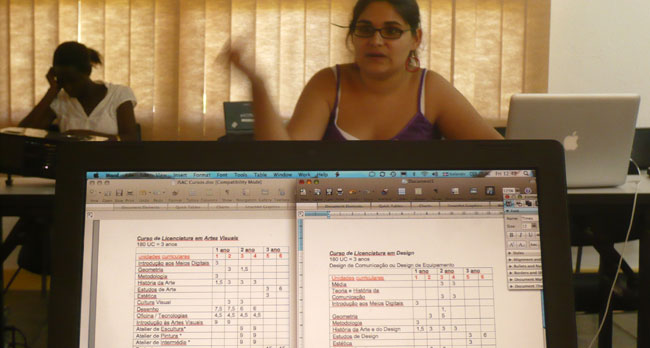TWO TYPES OF DIALOGUES ABOUT THE SAME ISSUE: ISAC
On day two of the week, full house listening to philosophy and visions
I am fine with understanding Portugese when we are in normal conversation, in shops etc. and I have given talks and lectures in the language, using PowerPoint for support. When the dialogue moves over to philosophical concepts and strategy, I must admit that I get a bit lost and make up my own interpretations. I do in a way create a personal fiction stimulated by what I hear. But it so happens that my first main education took place in Italian, so the terms are often similar. This blog is a reflection from sitting in a symposium in ISAC for a whole week, where the dialogue has been about a new school. The symposium was about what an art and design academy is and how to map the landscape that this school is being created in. Discussions all the way from copy machines to the post-modern condition and African culture. Very interesting reflections came up about how an establishment of a traditional art and design academy (in the model of Western tradition) is reflected or complimented in an African culture, that is really a cooking pot of latin colonialism (Portugal), Arab culture (they have been here for more than 1000 years) and the cooperation between local art with imported Western art. Professor Severino Ngoenha gave a talk named Post-Modernism and aesthetics. Great to listen afterwards to the dialogue about the mix, for example of traditional local dance (a fundamental strength here in Mozambique) and Western dance tradition. Something that I have really been wondering about when seeing celebrations of workshops where Northern people and local people create projects together. I still am not sure of what I think about it. Could it be a dance between the rich and the poor, and maybe the poor only dances because the others pay. I am going to think about this more when I see more.
 The dialogue did actually go this way: questions about acceptance of Post-Modernism (in brackets from me Western Capitalistic driven aesthetics) without some strong ethical platform to base the academic philosopy on. These preoccupations are exactly the same as mine.
The dialogue did actually go this way: questions about acceptance of Post-Modernism (in brackets from me Western Capitalistic driven aesthetics) without some strong ethical platform to base the academic philosopy on. These preoccupations are exactly the same as mine.
On the second day Dr. Emília Afonso gave a presentation about pedagocal methodology in universities, maintaining what I have also always meant that experience and tacit activity in the workshop is fundamental to the teaching of art. But she also maintained that similar principles are similarly valid in other specializations, like medicine etc.
Many speakers were invited and most of the new professors and leaders gave their opinions, but I am not going to list all the names here.
 Part of the group planning the design and art faculty
Part of the group planning the design and art faculty
 At last on the final day of the symposium people got down to the nitty gritty work of planning practical issues for the second semester that is going to be run. Rooms, who of the new teachers is taking responsibility for the courses that are written in the original document. This document has been in development during the last 3 years, I received it ca 2 years ago and gave my comments. It is now in a way fixed, like all ‘study plans’ – but of course has landed in immediate redevelopment like all study plans. It is of course true that institues develope strengths based on (a) the people that they are able to recruit, (b) location and culture and (c) political and economic conditions.
At last on the final day of the symposium people got down to the nitty gritty work of planning practical issues for the second semester that is going to be run. Rooms, who of the new teachers is taking responsibility for the courses that are written in the original document. This document has been in development during the last 3 years, I received it ca 2 years ago and gave my comments. It is now in a way fixed, like all ‘study plans’ – but of course has landed in immediate redevelopment like all study plans. It is of course true that institues develope strengths based on (a) the people that they are able to recruit, (b) location and culture and (c) political and economic conditions.
The students and teachers of ISAC were asked to come up with a proposal for a logo for the school. It is interesting how a discussion about a logo can be a tool for creating a common understanding of what the institute is. Therefore the proposals and the dialogue were very important for a group of people that are creating a new society with a common goal. Teachers, administration and students. The dialogue lifted almost all the issues that were spoken during the first days of the symposium, spoken by philosophers, professors, outside mentors and cultural experts. A discussion about a simple graphic image is sometimes more complete and on a more common level than dialogue about isms and future scenarios. It includes all!
 A planning photo. Maimuna and the tables with visual arts and design programs with credit counting etc.
A planning photo. Maimuna and the tables with visual arts and design programs with credit counting etc.
 February 22, 2010
February 22, 2010
 Tags: academy, art, DESIGN, maputo, mozambique Posted in: DESIGN
Tags: academy, art, DESIGN, maputo, mozambique Posted in: DESIGN


